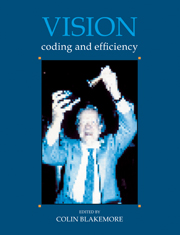Book contents
- Frontmatter
- Contents
- List of Contributors
- Preface
- Reply
- Acknowledgements
- Concepts of coding and efficiency
- 1 The quantum efficiency of vision
- 2 Coding efficiency and visual processing
- 3 Statistical limits to image understanding
- 4 The theory of comparative eye design
- Efficiency of the visual pathway
- Colour
- Brightness, adaptation and contrast
- Development of vision
- Depth and texture
- Motion
- From image to object
- Index
4 - The theory of comparative eye design
Published online by Cambridge University Press: 05 May 2010
- Frontmatter
- Contents
- List of Contributors
- Preface
- Reply
- Acknowledgements
- Concepts of coding and efficiency
- 1 The quantum efficiency of vision
- 2 Coding efficiency and visual processing
- 3 Statistical limits to image understanding
- 4 The theory of comparative eye design
- Efficiency of the visual pathway
- Colour
- Brightness, adaptation and contrast
- Development of vision
- Depth and texture
- Motion
- From image to object
- Index
Summary
Introduction
Perhaps the most fascinating and yet provocative aspect of vision is the manner in which eyes adapt to their environment. There is no single optimum eye design as physicists might like, but rather a variety of different solutions each dictated by the animals lifestyle, e.g. the ‘Four-eyed fish’, Anableps anableps, with one pair of aerial pupils and a second pair of aquatic pupils (Walls, 1942). This unique fish, which patrols the water surface, dramatizes the extreme plasticity of optics in adapting to a particular subset of the environment. The animal's life style within an environment obviously shapes many properties of the retina such as the distribution and types of rods, cones and ganglion cells (Walls, 1942; Hughes, 1977; Lythgoe, 1979). Furthermore, it is probable that the grand strategy of early visual information processing is also an adaptation to the particular world in which we live, i.e. a world of objects rather than the infinitely unexpected. We develop this perspective after considering the optical design of eyes.
Our first objective here is to show that elementary ideas of physics and information sciences can give insight into eye design. In doing so we stress the comparative approach. Only by studying diverse eyes, of both the simple and compound variety can we appreciate the common design principles necessary to apply meaningfully concepts from physics to biology. Accordingly, we try to explain observations such as: (a) the optical image quality is often superior to the photoreceptor grain; (b) the resolving power of falconiforms and dragonflies is proportional to their head size; (c) the cone outer segment diameter of diverse hawks that differ enormously in head size is fixed at about 2μm;
- Type
- Chapter
- Information
- VisionCoding and Efficiency, pp. 45 - 52Publisher: Cambridge University PressPrint publication year: 1991
- 1
- Cited by



